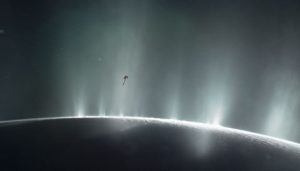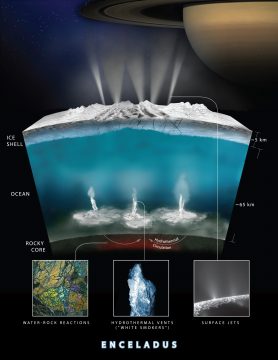Astronomers have more evidence that the hidden ocean inside Saturn’s moon Enceladus is heated by hydrothermal activity.

NASA / JPL-Caltech
In the last decade or so, planetary scientists have become increasingly convinced that hydrothermal activity occurs deep within the icy moon Enceladus. In this scenario, the moon’s briny water seeps into fissures in the seafloor, heats up thanks to the hot rock, and spews out again.
We know Enceladus has an ocean that’s (almost certainly) in contact with the moon’s rocky core. The Cassini spacecraft detected geysers spouting from the satellite’s south pole soon after its arrival in the Saturn system. Subsequent work has shown these are probably high-pressure leaks from a global subsurface ocean. Chemically speaking, the water in the plumes is tainted from being around rocks — just what you’d expect from hydrothermal activity.
There’s a lot of evidence for this picture, from the salt in the water to silica nanoparticles coughed out by the moon, the latter of which would have precipitated out of hot, rock-interacting water when it cooled. But scientists always want more data. One of the chemical fingerprints they’ve been hoping to find is molecular hydrogen. Rocks in a hydrothermal environment will leach oxygen from water, producing hydrogen. In fact in 2015 Yasuhito Sekine (University of Tokyo) and others noted that in the conditions implied by the silica nanoparticles’ creation, hydrogen production “would proceed efficiently.”

NASA / JPL-Caltech
Last October, Cassini scientists did their penultimate flyby of the little moon with the specific goal of finding this hydrogen. Reporting in the April 14th Science, J. Hunter Waite (Southwest Research Institute, San Antonio) and colleagues confirm they’ve succeeded.
The heat in Enceladus’s ocean exists because of Saturn. The giant planet tidally wrenches the little moon in the same way the Moon creates tides on Earth, or Jupiter creates volcanism on its satellite Io. This tidal pull warms and cracks the moon’s rocky core. Seawater flows into these cracks, heats up, and comes back out. The inferred temperature is high enough that the process might create large-scale convective motion (think “pot of boiling oatmeal”), Sekine, Hsiang-Wen Hsu (University of Colorado, Boulder) and others speculated in their silica analysis.
This new result has crucial implications for astrobiology. Molecular hydrogen’s production creates a chemical imbalance in the surrounding seawater, because the hydrogen “wants” to react with other things. Some of the most ancient forms of life on Earth exploit this imbalance by eating hydrogen and metabolizing it, living off the chemical energy and making methane. (Cassini has previously detected methane, but don’t get too excited: The high hydrogen levels would favor its creation in reaction with carbon dioxide in the ocean, no microbes required.) The new result will help astrobiologists understand the energy available to potential organisms inside the moon.
“I think this is a unique new insight from this work,” Hsu says, who wasn't involved with the study. “It surely opens new windows for people to think and speculate about the chemistry within the subsurface ocean.”
Among those speculating, astrobiologist Mary Voytek (NASA) says that the abundant hydrogen and carbon dioxide seen actually disfavors life in her mind. "If there is life, it’s not very active," she said in an April 13th press conference. Think of hydrogen like pizza. "When you have stacks of pizza, much like in a graduate school department, it disappears. So we have this buildup of food that’s not being used."
In tandem with Cassini's Enceladus result, astronomers also announced news about a second icy moon: Jupiter's Europa. In 2014 the Hubble Space Telescope detected a hint of geyser activity from this moon, too. Reporting in the April 20th Astrophysical Journal Letters, William Sparks (Space Telescope Science Institute) and colleagues say they've seen a possible plume in 2016 data, in the same place as one of those seen in 2014 — and where the Galileo orbiter saw a "heat anomaly" way back in 1999.
The detection is at the limit of what Hubble can do, so it's not unequivocal, Sparks cautions. But like Enceladus, Europa is tidally squeezed due to its parent planet. Maybe that creates some sort of pseudo-plate tectonics, explaining the moon's young-looking surface.
References:
J. Hunter Waite et al. “Cassini Finds Molecular Hydrogen in the Enceladus Plume: Evidence for Hydrothermal Processes.” Science. April 14, 2017.
Yasuhito Sekine et al. “High-temperature Water-rock Interactions and Hydrothermal Environments in the Chondrite-like Core of Enceladus.” Nature Communications. October 27, 2015.
Hsiang-Wen Hsu et al. “Ongoing Hydrothermal Activities Within Enceladus.” Nature. March 12, 2015.
W. B. Sparks et al. "Active Cryovolcanism on Europa?" Astrophysical Journal Letters. April 20, 2017.
Check out JPL's infographic about Enceladus, or daydream about visiting the moon and other space destinations with NASA's Visions of the Future posters.
 3
3









Comments
Anthony Barreiro
April 13, 2017 at 6:50 pm
I've seen several reports about Enceladus in the general interest media today. None of them have pointed out the similarity between molecular hydrogen and uneaten pizza, and what this says about the likelihood of life there. Once again, Sky and Telescope presents breaking news in a way that's intelligible to the lay reader, without glossing over the complexities. Thanks.
You must be logged in to post a comment.
hardtop4
April 15, 2017 at 5:27 pm
This little moon of Saturn system needs to explore
some more with a spacecraft landing near one of these events.
and seeing close up what is really going on.
You must be logged in to post a comment.
Shannon Sims
April 27, 2017 at 10:05 pm
Other research points to the possibility of a magnetic/electrical source for the hydrogen. Hydrothermal vents and the possibility of life are still only conjecture at this point.
You must be logged in to post a comment.
You must be logged in to post a comment.